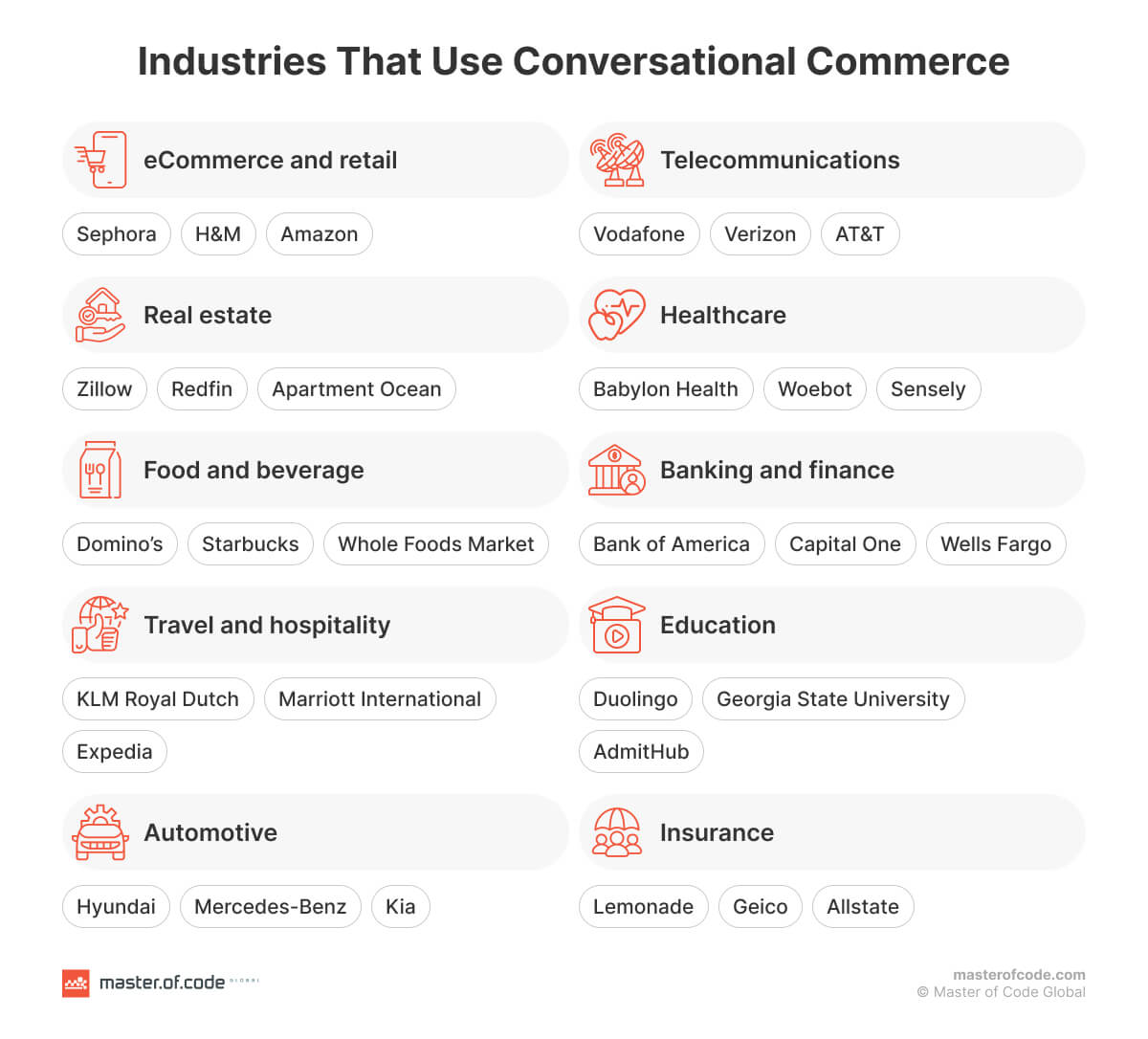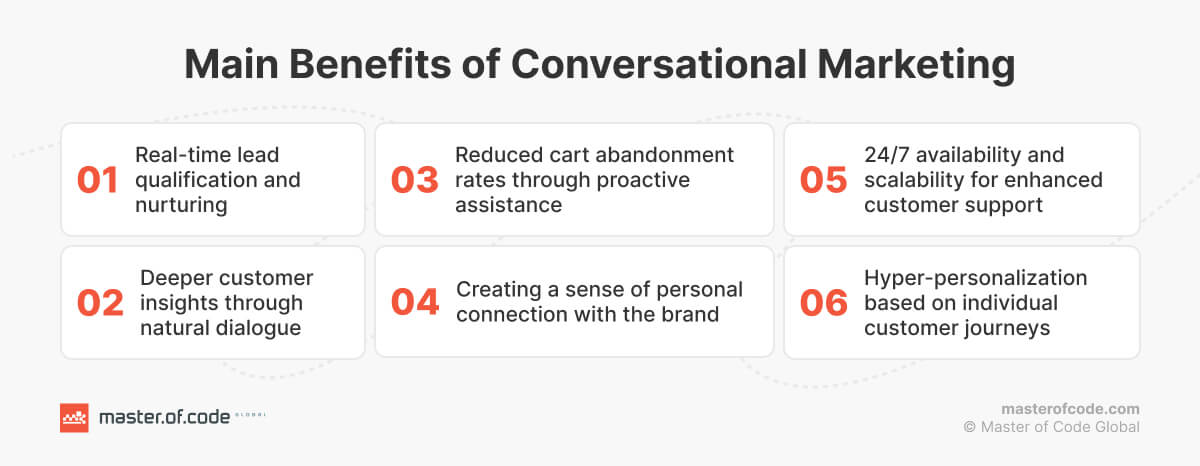Waiting on hold or navigating a confusing website is a quick way to lose a deal. Conversational commerce fixes that by letting people shop the way they prefer to talk – through messaging. Today’s AI assistants can understand what customers want, learn from past chats, and offer genuinely helpful, personalized advice 24/7.
And it’s not a niche trend. Global conversational commerce is expected to reach $41 billion by 2030. Right now, businesses are moving from static web pages to active chats. In this article, we’ll break down the specific use cases that drive sales, share real-world examples of successful implementation, and explain the core technologies that make it all work.
Table of Contents
What Is Conversational Commerce?
Forget long phone queues and robotic service. Online retail is shifting its focus to communication, putting the ‘chat’ in shopping. It’s about turning interactions into tailored dialogues that build trust and loyalty.
Picture messaging your favorite brand on WhatsApp for style advice, or getting instant answers to product questions on Facebook Messenger. That’s conversational commerce in action – a blend of shopping and communication across the platforms your customers already use. Powered by chatbots integrated into the common messaging apps, it’s about giving your users the convenience of a 24/7 personal purchaser. This approach replaces one-way sales pitches with helpful, two-way dialogues.
How Conversational Commerce Works
- Natural Language Processing (NLP): This is the AI’s ability to understand human language. NLP analyzes your questions, whether you type “Where’s my order?” or “Can you help me find the package I bought last week?” It grasps the intent behind your words, even with typos or slang.
- Machine Learning (ML): This technology acts as the system’s brain, learning from data. ML analyzes your browsing history, past purchases, and preferences to offer smarter, more relevant suggestions over time. It’s how a bot recommends a product you’ll actually love.
- Generative AI: This capability is what allows the AI to create new, relevant responses, moving beyond pre-written scripts. Instead of relying on a fixed one, the model crafts dynamic, context-aware answers, turning a simple Q&A into a genuine dialogue.
Unpacking the Numbers: Key Conversational Commerce Statistics
- The global conversational commerce market was valued at $7.25 billion in 2024 and is projected to grow to $64.03 billion in 2034, according to Precedence Research.
- According to Rep AI’s data, 12.3% of shoppers who engage with AI-powered chat make a purchase, compared to just 3.1% of those who do not.
- 66% of consumers are interested in trying Gen AI-powered conversational commerce.
Conversational Commerce vs. Social Commerce: What’s the Difference?
Social type is about the platform. It refers to the entire shopping experience taking place directly within a social media app like Instagram, TikTok, or Facebook. You discover a product in your feed, click “Buy Now,” and complete the purchase without ever leaving the app.
Conversational type, on the other hand, is about the method. It uses dialogue to guide the sale and can happen anywhere – on a brand’s website, via WhatsApp, or through DMs on a social platform.
Conversational Commerce vs. Conversational Marketing: A Tale of Two Goals
Conversational marketing is all about starting the dialogue and building a relationship. Its main goal is engagement and lead generation.
This strategy uses chatbots and other interactive tools to create a more human-like, personalized experience at the top of the sales funnel. It’s highly effective: 79% of companies report that using these tools has boosted user loyalty and revenue.
By meeting shoppers’ expectations for real-time communication (a priority for 71% of consumers), in-chat marketing captures user attention, answers initial questions, and guides your prospects until they become a qualified lead.
Conversational AI for ecommerce takes over once a shopper is ready to buy. Its primary goal is to facilitate a transaction. This is where the dialogue shifts from general engagement to specific actions, like helping with product selection, completing the purchase, and providing post-sale support such as order tracking, all within the same interface.
Advancements in Generative AI and Conversational Commerce Strategy
The leap to GenAI isn’t just an upgrade; it’s a shift in what chatbots can do. While older chatbots were good at handling simple, predictable tasks, Generative algorithms allow you to build a strategy around proactive, intelligent, and personalized engagement at every stage of the customer journey.
For example, lead nurturing evolves from sending generic coupons to having an AI-powered consultant that asks about your goals and recommends a personalized bundle of products. Similarly, after-sales service shifts from just providing an order status to proactively solving issues, understanding your frustration, and offering a relevant discount to strengthen loyalty.
Ecommerce conversational AI enables a strategy where every interaction becomes an opportunity. With the right tech partner, you can create a system that doesn’t just answer questions but also gathers nuanced feedback, cross-sells intelligently, and makes every client feel like they are receiving one-on-one attention from an expert. The focus moves from automating simple answers to building and maintaining customer relationships at scale.
Types of Conversational Commerce
Intelligent Bots
AI chatbots for eCommerce can answer FAQs, recommend products, or even help with checkout – all while sounding remarkably human.
Voice Assistants
Hey Siri, find me the perfect pair of sneakers! These agents are transforming AI conversational commerce, letting your customers shop hands-free with simple spoken commands.
Individual Buying Assistants
Whether in-store or online, they can offer tailored recommendations and style advice, creating a VIP buying engagement. For those who crave a truly bespoke journey, a personalized shopping experience is the answer.
Messaging Apps:
- SMS : The OG of messaging is making a comeback! Businesses can now use the short message service to engage buyers in real-time, send individualized offers, and provide instant support. It’s a simple yet powerful way to build stronger relationships and drive sales.
- WhatsApp : The go-to app for connecting with friends and family is also becoming a powerful tool nowadays. By incorporating WhatsApp conversational commerce, companies can transform customer experience by tapping into a massive global audience, offering expert advice on demand, and boosting sales through engaging dialogues.
- Facebook : Social media giant’s messaging platform is not falling behind its peers. Organizations are now using Facebook conversational commerce to automate responses, schedule appointments, and offer exclusive deals directly through the platform’s ecosystem. Its popularity among businesses is backed by the fact that it counts 2.11 billion active users daily.
GenAI
This technology is especially powerful for creating unique content in real-time. Generative AI in eCommerce can craft personalized product descriptions, as well as unique marketing copy, or even design custom images – all on the fly, tailoring the user journey in real-time.
The Key Benefits of Conversational Commerce
After delivering over 1,000 successful AI projects, we’ve seen firsthand what works. The most consistent finding is that shifting from static web pages to dynamic, two-way dialogues is no longer optional – it’s a core strategy for growth.
Our solutions have directly helped clients achieve outcomes like a 3x increase in conversion rates and an 80% improvement in customer satisfaction. This all comes down to improving customers’ experiences with conversational commerce. So, let us break down what are the real, tangible benefits of conversational commerce that your business can face quite soon after the implementation.
1. Enhanced Client Engagement and Satisfaction
This transforms shopping from a one-way street into a dynamic chat. In practice, this means a shopper isn’t just passively browsing your site; they’re actively interacting.
This resolves doubts on the spot, turning hesitation into a confident purchase and significantly boosting client satisfaction metrics. Daily operations change from passively waiting for sales to actively guiding prospects to the perfect product.
2. Improved 24/7 Customer Service
With the conversational commerce features, your company can offer instant, round-the-clock support without needing a massive, global team. A common business challenge is handling basic, repetitive questions that clog up support queues.
For example, a client in London can get an instant shipping update at 3 AM your local time, while your human agents are asleep. As a result, your support staff can log in each morning to a cleaner queue, focusing their expertise on complex, high-value issues that require a human touch.
3. Increased Sales and Reduced Cart Abandonment
Think of conversational commerce as a smart, automated sales assistant. For instance, when a customer adds a laptop to their cart, the system can proactively ask, “Would you like to add a compatible mouse for 20% off?” This simple, contextual upsell feels helpful, not pushy, and can consistently increase your average order value (AOV).
Furthermore, if a user is hesitating on the checkout page, a message can pop up offering assistance or even a small, time-sensitive discount to close the deal. For a business doing $50,000 in monthly sales, a 15% boost in AOV from these automated suggestions translates directly to an extra $7,500 in revenue per month.
4. Streamlined Shopping and Reduced Friction
The traditional online journey involves multiple clicks: homepage -> category page -> product page -> cart -> checkout. AI conversational commerce condenses this into a single window. A customer can type, “I need a formal blue tie,” see the options, add one to their cart, and complete the purchase all within the same chat interface. This dramatically reduces the number of steps and potential drop-off points. In daily practice, you’re removing barriers and making it as easy as possible for a shopper to give you their money.
5. Stronger Customer Loyalty and Retention
Loyalty is built on personal connection and feeling understood. Conversational commerce tools excel at creating these individualised experiences at scale. Imagine someone who previously bought a specific skincare product returns to your site. A bot can greet them with, “Welcome back! Running low on your favorite moisturizer? You can reorder it with one click.”
This recognition makes the buyer feel valued, not just like another transaction number. These small, personalized interactions transform a transactional relationship into a loyal one, significantly increasing customer lifetime value (CLV) and encouraging repeat business.
6. Valuable Data for Smarter Decisions
Every talk is a source of direct, unfiltered feedback. Instead of waiting for survey results, you get real-time insights. If ten people ask in one day whether a certain coat is waterproof, you’ve just identified a critical piece of information missing from your product description. You can update it immediately. If you notice a spike in questions about shipping to a specific country, you have clear data indicating a new market opportunity.
This turns customer service from a cost center into an invaluable business intelligence tool, allowing you to make quick, data-driven decisions about marketing, product development, and inventory.
7. Omnichannel Support
This is the essence of omni-channel conversational commerce: providing a consistent, seamless experience wherever your clients choose to interact with you, be it on your website, Facebook Messenger, WhatsApp, or Instagram. In practice, this means a customer can start a query on an Instagram DM and later continue it via a chat on your website without having to repeat their issue.
For your support team, this creates a unified profile, where they can see the entire chat history across all channels in one place. This prevents frustrating the shopper and empowers your agents to provide faster, more contextual, and ultimately more effective support.
Using Conversational Commerce in Different Industries
Retail
According to Juniper Research, the total spending on OTT-based shopping assistance is expected to increase by 89% over the next year, fueled by the growing popularity of the eCommerce and retail sectors.
Bots have already been employed by major brands like H&M and Sephora to provide style advice, and even assist with purchases directly within messaging apps. A well-designed conversational chatbot for ecommerce can engage users in a playful quiz, like H&M does, to determine their style preferences and then offer tailored product suggestions.
Conversational commerce in retail is also changing the way consumers interact with brands. A simple voice command like “Alexa, reorder my favorite coffee” streamlines the purchase process, making it effortless to replenish their supplies.
Telecom
The industry often grapples with complex queries and billing issues. Conversational commerce in telecom can automate a significant portion of customer support, freeing up human agents.
Vodafone’s TOBi chatbot is a great example of handling over a million interactions per month, providing instant answers to common queries and troubleshooting technical problems. Messaging apps are also a powerful channel for telecom companies to connect with users.
These apps enhance consumer interactions and drive personalized experiences, offering individual solutions and support in real-time. With over 2 billion monthly active users on WhatsApp, brands like Airtel have integrated their services into the platform, allowing clients to manage their accounts, pay bills, and even recharge their plans without leaving the app. This accessibility boosts convenience and strengthens brand engagement.
Other Enterprises
The versatility of conversational commerce extends beyond retail and telecom, benefiting a wide range of industries:
- Travel: Kayak’s bot allows website visitors to search for flights, hotels, and rental cars directly within Facebook Messenger, providing a convenient and dedicated travel planning flow.
- Banking: Bank of America’s Erica bot assists clients with tasks like checking balances, paying bills, and even offers financial advice. The AI banking chatbot is providing 24/7 support and exclusive guidance.
- Healthcare: Buoy Health’s AI-driven assistant guides users through a symptom-checking process, offering potential diagnoses and suggestions on when to seek medical attention. Here conversational commerce for enterprise is offering a convenient way to access preliminary advice.

Leading Conversational Commerce Use Cases with Illustrations
From product discovery to post-purchase support, AI offers innovative ways to streamline the buying journey. Here are some of the top applications:
Product Information & Item Specifications
Accessing information about products or services can be a major friction point for customers, often requiring them to sift through dense spec sheets or confusing technical jargon. Conversational commerce solves this by turning a one-way data dump into a dynamic, two-way dialogue. Instead of just reading a list of features, you can ask specific questions and get immediate, context-aware answers, making complex information easy to digest.
A great example is how KIA tackled the overwhelming process of car shopping. They leveraged a Facebook Messenger bot to create an interactive car configurator where you can explore models, customize features, and get instant price estimates. This gamified approach allows you to ask directly about item specifications, like engine performance or available colors, and understand how different options affect the final product.
Order-Related Services (Tracking, Stock Inquiries, Exchanges & Refunds)
Managing orders after a purchase is often the most frustrating part of the client journey, involving confusing tracking portals and complicated return forms. Conversational commerce streamlines these essential services by placing them all within a single, easy-to-use chat window.
This approach also handles proactive inquiries, like asking a bot to notify you when an out-of-stock item is available again, eliminating the need to repeatedly check the website. By automating tracking, stock inquiries, exchanges, and refunds, you not only provide a frictionless experience for your customers but also significantly reduce the workload for your human support team.
Payment Methods & Subscription Management
Conversational commerce simplifies complex financial transactions by bringing them into a secure, intuitive chat interface. For instance, sending money internationally can be a complicated process, but Western Union’s bot streamlines it by allowing you to initiate transfers, track them in real-time, and get fee information without leaving the app. This approach removes the need to navigate confusing websites or visit a physical branch, making the entire payment process faster and more convenient.
The same simplicity is invaluable for subscription management. Instead of searching for a hidden settings page to change your plan, you can easily tell a bot, “Pause my subscription for one month,” or “Upgrade to the premium tier.” This puts you in direct control of any recurring payments, allowing you to easily manage available services, update payment details, or cancel a subscription through a quick, straightforward chat.
Restock & Notification Bots
Traditional restock alerts often require creating an account or submitting an email. This is a major point of friction that leads to cart abandonment 31% of the time. Conversational commerce notification bots solve this by working on messaging platforms clients already use, like WhatsApp or Facebook Messenger.
A great example is how Tommy Hilfiger turns a disappointing “out of stock” moment into a re-engagement opportunity. Their virtual assistant allows you to sign up for an alert on a specific item and receive a message the moment it’s available again.
Beyond restocks, these bots can act as proactive promotional tools. The corporate catering service Forkable, for example, uses its virtual assistant to guide potential clients through menu options based on their budget and dietary needs.
Customer Loyalty Programs
This can generate 2.5 times greater revenue than companies that don’t (in the same industry), according to a 2020 Harvard Business Review study.
There are multiple AI chatbot examples of conversational tech in customer loyalty programs, including using bots to automate engagement. Consumers want to feel rewarded and acknowledged but doing this manually is impossible and automated CRM solutions are expensive. Chatbots are a great option for engaging clients efficiently after certain triggers (such as making a purchase or adding products to the cart). Some ways of using chatbots to strengthen customer loyalty and drive engagement include:
- Sending personalized messages after certain actions;
- Asking consumers to review previous purchases through an easy chat window;
- Allowing consumers to set price reminders using the chat window.
Tailored Product Suggestions
Luxury Escapes, a travel company, leverages our custom-developed bot to deliver personalized recommendations. By asking about preferences and budget, this conversational commerce solution suggests destinations and packages that perfectly match users’ needs, eliminating the time-consuming search process.

In just three months since launch, over 6,200 users have engaged with the tool, viewing 4,070+ deals. The bot’s fun “Roll the Dice” feature has been played 16.8K+ times, keeping consumers entertained. With 7,400+ retargeted users and an 89% reply rate, the bot has generated $300K+ in revenue within the first 90 days, driving engagement and sales.
La Mer, the luxury skincare icon, also wanted to bring the personalized magic of its in-store experience to the digital world, and Master of Code Global delivered. With over 3,350 expertly trained utterances, the conversational commerce tool transforms online shopping into an interactive, well-mapped journey.
The “Find My Regimen” quiz gives users tailored skincare recommendations, while 5 new features keep engagement high. Customers can dive deep into product details, explore ingredients, and discover La Mer’s rich history, all through a conversational experience. For more complex queries, live chat integration ensures a smooth transition to human support. Backed by 7 years of dedicated service, the La Mer bot redefines user satisfaction, blending luxury with cutting-edge technology.

Lead Generation & Nurturing
Conversational AI solutions for eCommerce are capable of parsing large data sets which means they can be used to automate cold outreach and lead generation. For instance, chatbots can use artificial intelligence to create segments within an audience (consisting of visitors, people who like, or view related content) and target these segments with different types of incentives.
How can bot generate leads?
- Sending the user more content that is similar to the things they liked or watched in the past;
- Use location data to find nearest stores and send potential reservation times;
- Send marketing content to encourage action such as visiting a specifically designed landing page.
Once a prospect connects back, they become a warm lead. This is the point when a bot goes into lead nurturing/management mode. Thanks to the natural speech capabilities of Conversational AI, chatbots can continue the dialogue and further engage with leads by guiding them through the sales funnel until they are ready to convert.
How can bots nurture leads?
- Giving personalized recommendations based on the lead’s likes and dislikes;
- Knowing when the potential customer is losing interest (one indicator is slow responses) and switch tactics;
- Sending coupons, rewards, and other discount offers.
External Points of Sale & Business Messaging Bots
Conversational commerce is rapidly becoming the standard for business messaging, allowing you to connect with users on the platforms they use every day, such as WhatsApp, Facebook Messenger, and Google RCS. This shift does more than just open a new line of communication; it transforms these messaging apps into a complete Point of Sale (PoS).
Each bot can be designed to guide people through the entire customer journey, from product discovery to a seamless checkout, all without ever leaving the chat window. This is especially effective for everyday purchases like groceries or clothing, where users feel more comfortable completing the sale within a conversation.
The experience can be enhanced with interactive, rich-media messages and even include natural opportunities for upselling or cross-selling, where the bot recommends relevant products with a brief, helpful explanation.
Appointment Scheduling
Aveda, the global leader in botanical hair and skincare, partnered with Master of Code Global to elevate their online booking system and make it as immersive as their in-store experiences. Instead of the tedious task of filling out multiple form fields, users can now use a guided, conversational commerce chatbot to book appointments in just a few clicks.
The campaign fueled explosive growth, with a 7.67x surge in weekly bookings and a staggering 378% increase in lifetime users. By continuously refining the bot’s NLP and analyzing client behaviors, our team ensured that Aveda’s digital experience remained fresh, personalized, and irresistibly engaging.

Digital Shopping Assistants (Chatbots & Virtual Assistants)
Burberry, a global icon of British luxury, teamed up with Master of Code Global to elevate online shopping with their concierge bot. Integrated into Facebook Messenger, these types of AI-powered conversational commerce chatbots deliver a personalized, high-end experience by offering real-time assistance, curated style recommendations, and the ability to shop runway collections.

Similarly, Four Seasons Hotels leverages an assistant to handle guest requests and inquiries. From booking reservations to arranging transportation, the bot provides dedicated help around the clock. This enhances the guest contentment and frees up hotel staff to focus on other tasks.
As we said at the beginning of the article, customer service was one of the first conversational AI use cases in eCommerce and it continues to be a major AI use case in 2026 as well.
There are other benefits of using chatbots for customer service:
- Reduced dependence on human staff;
- Client support available 24/7;
- Scalability as AI bots are capable of processing upwards of millions of queries a day.
Want to learn how conversational commerce for business personalizes the fashion industry? Read also: Generative AI Personalization for Fashion Retail
Channels & Platform Considerations
The landscape is diverse, ranging from on-site chatbots that act as a virtual front door to your business, to messaging apps like WhatsApp and Messenger that are ideal for deep engagement and sales.
Emerging channels like social media DMs capture interest at the point of discovery, while Google RCS and Apple Messages for Business offer rich, native experiences on smartphones, and voice assistants provide hands-free convenience for simple tasks.
Your final decision about Conversational commerce integration should be a strategic one, driven by a few key factors. First and foremost, consider your audience’s habits: where do they spend their time? Next, align the channel with your business goal, whether it’s simple customer support or a complex sales journey. Finally, match the complexity of the task to the platform’s capabilities and be mindful of your global reach, as app popularity can vary significantly across regions.
Live Streaming & Social Shopping
Online shows blend entertainment with e-commerce, allowing you to watch a live video where a host demonstrates products in real time. The conversational AI-powered ecommerce experiences happen in the chat, where you can ask questions, request to see a product from a different angle, and get immediate answers from a specialist.
This real-time dialogue builds immense trust and creates a sense of urgency. Platforms like TikTok Shop and Amazon Live are integrating “social shopping” features that allow you to click a pop-up and purchase an item the exact moment it’s being shown on screen.
Click-to-Message Advertisements
Instead of sending you to a generic landing page after you click, these ads open a direct conversation in a messaging app like Facebook Messenger, WhatsApp, or Instagram. This strategy gives businesses a powerful advantage by allowing them to engage with you instantly, capture your specific needs, and qualify leads in real-time. A well-designed bot can handle the initial interaction 24/7, answering your questions or gathering key information before handing the conversation over to a human agent if needed.
Search Engine Result Business Profiles & Market Research and Feedback Bots
Features like Google Business Profile now include “Chat” buttons that allow you to start a conversation with a company directly from your search results. This provides a completely frictionless way to ask a quick question about store hours, product availability, or services without ever needing to navigate a full website. Conversational commerce is a perfect way to provide immediate answers at the peak of clients’ interest.
This direct line of communication is also a powerful tool for market research and gathering feedback. After a bot has answered your initial query, it can follow up with a simple question like, “How was your experience today?” or “Is there anything we could do better?”
New Frontiers (AR/VR, Metaverse & Emerging Tech)
Augmented Reality (AR) is already allowing you to virtually “try before you buy.” Imagine talking to a bot about a new sofa and then, with a simple request, seeing a 3D model of it appear in your living room through your phone’s camera. This blends digital chat with your physical reality, answering critical questions about size, style, and fit in a highly engaging way.
Looking further ahead, Virtual Reality (VR) and the Metaverse will transform Conversational AI from a text-based assistant into an embodied, intelligent avatar. Instead of chatting with a bot, your consumers will walk through a virtual store and talk to a personal shopping assistant who can walk with them, showcase 3D products, and provide expert advice in a fully immersive world. In these new frontiers, a basic chat becomes the primary user interface, the natural way people navigate and interact with the next evolution of e-commerce.
Identification & Verification
Traditional methods that redirect users to a separate login page break the dialogue flow, creating friction and doubt. Conversational commerce solves this by integrating secure, modern verification methods directly into the chat, making the process feel both effortless and safe.
Picture a bot prompting you to approve a sensitive transaction using your phone’s built-in Face ID or fingerprint sensor, or by simply typing in a one-time password (OTP) sent directly to you via SMS. The entire process happens within the chat, maintaining the flow and context of your interaction. This not only makes verification faster and easier for your buyers but also builds the confidence needed to complete high-value transactions securely.
Examples of Conversational Commerce
Social Messaging, SMS & MMS
Apps like WhatsApp and Facebook Messenger are perfect for deep, ongoing engagement, from providing personalized style advice to completing a sale and handling post-purchase support. SMS remains the most direct channel for time-sensitive alerts like flash sale announcements or shipping notifications, while MMS enhances this with visual content, allowing you to send images and GIFs of products to create a more engaging experience.
Ecommerce Search Bars
Instead of just matching words, modern search bars can understand natural language queries like, “Show me waterproof hiking boots under $200.” They can also proactively suggest prompts to guide your search, turning a simple query into an interactive dialogue with an AI assistant that helps shoppers find exactly what they need, faster.
Real-World Brand Examples
At Master of Code, we’ve had the privilege of building cutting-edge conversational commerce applications for some of the world’s most ambitious brands. Here are a few examples of our work:
Shopify merchants faced the challenge of increasing average order value (AOV) without disrupting the customer checkout flow. To solve this, we developed the OneClickUpsell (OCU) application, the first of its kind to offer seamless, one-click post-purchase upsells. Our solution was later enhanced with a proprietary Generative AI model that delivers dynamic, personalized offers based on cart contents and automates product descriptions. As a result, merchants using OCU have seen a 10-50% increase in AOV, contributing to over $700M in total upsell revenue generated across more than 11,000 active stores.
An electronics manufacturer needed to launch an effective direct-to-consumer sales channel on a tight deadline before the Black Friday shopping season. We created an Apple Messages for Business chatbot with deep Shopify integration, serving as a virtual shopping assistant. The GenAI-powered bot we built engages clients with product recommendations, allows them to view and edit their cart, and assists with checkout, all within the chat. This solution successfully launched in time for the sales event, achieving an 84% engaged session rate, an 80% average customer satisfaction score, and contributing to an average order value of approximately $300.
A global luxury jewelry brand struggled to provide continuous, 24/7 support to clients across the UK, USA, and Canada due to differing time zones and agent working hours. Our solution was a sophisticated routing bot for Apple Business Chat that intelligently manages client support. The bot we designed analyzes the user’s location and current staff availability to direct their query to an active human agent, ensuring someone is always available. This eliminated the issue of agent unavailability, successfully handling over 4,600 conversations in the US in a single month and providing instant, reliable support to a global clientele.
For its Mother’s Day campaign, floral subscription company BloomsyBox wanted to create a highly personalized and memorable gift-giving experience that went beyond a simple purchase. We developed a GenAI-powered bot that hosted a daily quiz where users could win a free bouquet. Our innovative solution allowed winners to use Generative AI to craft unique, heartfelt greeting cards for their mothers. This transformed a standard marketing campaign into an emotional experience, resulting in high engagement, with 60% of users completing the quiz and 78% of winners claiming their prize, thereby strengthening customer loyalty.
The primary challenge for many Shopify merchants was creating high-converting, professional landing pages without needing coding expertise. We built Zipify Pages, a powerful and intuitive drag-and-drop page builder designed specifically for e-commerce. To further empower merchants, we integrated a GenAI feature that automatically generates high-converting copy for product descriptions and other on-site content. Our work has resulted in a solution trusted by over 15,000 brands, helping them improve sales and build a strong online presence across more than 100,000 active pages.
Integrable Voice Assistant Case Study
The market lacked a versatile voice assistant that could be easily integrated into any application, as existing solutions were confined to closed ecosystems. To solve this, we created a custom, lightweight voice assistant framework built natively for iOS and Android. Our solution allows for the rapid development and deployment of customized, voice-activated experiences within any existing app. The primary business benefit is a significantly faster time-to-market for our clients looking to add sophisticated, hands-free voice interactions to their platforms across various industries.
Small to medium-sized Shopify businesses needed a unified tool to improve customer communication and simplify marketing efforts. We developed ShopJedAI, an AI-driven marketing and support solution for Apple Business Chat. Our platform combines a smart shopping assistant that answers questions and processes purchases in-chat with a tool that helps merchants create high-performing ad campaigns. This provides a direct communication channel that streamlines the user journey. At the same time, it simplifies the merchant’s daily marketing tasks, delivering correct answers 86% of the time.
An online homeware marketplace needed to ensure its LLM-powered chatbot was secure from vulnerabilities and that its conversational design fostered user trust. For this client, we conducted a comprehensive security and usability audit across the bot’s entire lifecycle, from pre-development design reviews to post-deployment penetration testing. The proactive approach we took identified and mitigated critical risks like data leakage and prompt injection. The audit not only enhanced data protection but also delivered tangible business benefits, including preventing an estimated $80,000 in potential breach costs and contributing to a 10% rise in AOV due to increased customer satisfaction.
Chatbot for a Leader in Luxury Fashion Consignment
A high-end consignment brand faced the challenge of translating its signature “white-glove” consumer service to a digital bot experience for both buyers and sellers. We developed a sophisticated chatbot with exclusive features tailored for luxury clientele. For example, these were routing VIPs to dedicated agent teams (“Pod Routing”) and automatically reconnecting users to their previous agent (“Auto Resume”). Our solution successfully replicated the brand’s premium service, achieving an 89% average CSAT score and a 91% first-contact resolution rate, thereby enhancing the luxury customer journey.
To stand out during the crowded holiday season, Tom Ford Beauty needed an engaging way to connect with buyers and guide them to the right products. For their campaign, we created a personalized “Gift Finder” chatbot on Facebook Messenger that acted as a virtual concierge. The bot we built asked users a series of questions about their gifting needs and provided tailored product recommendations with rich visuals and direct links to purchase. This interactive campaign successfully captured shoppers’ attention, engaging over 8,000 users and driving more than 2,000 clicks to their e-commerce website in just one month.
Zipify Agent Assist Case Study
Zipify’s customer support team struggled to scale efficiently due to a high volume of repetitive inquiries and a lack of tools for analyzing performance. To address this, we developed a custom AI-powered Agent Assist solution with two components: a virtual assistant integrated into Intercom to provide agents with real-time answers, and an analytical dashboard to track metrics. The assistant we designed also automatically converts support conversations into new knowledge base articles. This system significantly increased our client’s support efficiency, reduced agent workload, and provided data-driven insights for continuous improvement.
How to Get Started with Conversational Commerce: Best Practices
1. Start Small with a Clear Use Case
Instead of trying to build a bot that can do everything, identify one significant customer pain point and start there. Begin with a narrow, high-impact use case like automating answers to your top 5 most frequently asked questions or providing instant order status updates. This approach allows you to deliver immediate value, measure success with clear metrics, and learn from real interactions before you expand to more complex flows.
2. Be Proactive, Not Just Reactive
The real power of conversational commerce may be witnessed when you initiate helpful chats, not just wait for clients to ask a question. Be proactive. Set up a bot to send a personalized welcome message to a new website visitor, a helpful reminder about an abandoned cart, or a back-in-stock notification for a desired product. This shifts the dynamic from a passive browsing session to an active, engaging dialogue that guides clients and recovers potential lost sales.
3. Embrace AI and Automation
These are the two engines that allow you to provide individualised experiences at scale. A well-trained AI bot can handle thousands of conversations simultaneously, ensuring every customer receives an instant, accurate response 24/7. The goal of automation is not to replace your human team but to empower them. By handling routine inquiries, the bot frees up your expert agents to focus on the most complex, high-value interactions that require a human touch.
4. Plan Integrations for True Personalization
A standalone bot is only as smart as the information it’s given. More precise tailoring comes from connecting a conversational platform to your core business systems. Plan your integrations carefully so the new bot can access data from your CRM, Customer Data Platform (CDP), and e-commerce platform (like Shopify). This connectivity is what allows the bot to greet a client by name, recommend products based on their purchase history, and provide an exclusive experience.
5. Use Rich Messaging to Create Engaging Flows
Modern conversations are more than just text. Your store can also apply the rich features of today’s messaging platforms to create app-like experiences directly within the chat. Use visual product carousels, quick-reply buttons, high-resolution images, and even embedded payment flows. These elements make the interaction more intuitive, visually appealing, and efficient, transforming a simple chat into a powerful tool that holds attention and drives conversions.
Technologies Behind AI Chatbot for Conversational Commerce
To create an engaging and helpful experience, several key technologies must work together. Here’s a look at the core stack powering modern AI chatbots:
Conversation Design
According to the MIT Technology Review, executives see an 80% improvement in customer satisfaction, service delivery, and overall contact center performance after incorporating AI bots. This growth could be reached only by applying the most recent and successful practices of conversation design, which is the backbone of any virtual assistant. It involves crafting natural, engaging dialogues that guide buyers through the funnel.

This goes beyond just answering questions; it’s about understanding user intent, providing relevant information, and offering exclusive recommendations. CD teams use techniques like branching narratives, entity recognition, and sentiment analysis to create dynamic conversations that mimic human interaction. They also ensure the bot’s personality aligns with the brand’s voice and values.
Machine Learning
ML is the engine that drives a virtual assistant’s ability to understand and respond to queries. Natural Language Processing (NLP) enables the solution to comprehend the nuances of human language, including slang, idioms, and misspellings. It also helps the conversational commerce digital agent extract key information from chats. This can be product preferences, order details, or user sentiment. Custom machine learning development services help analyze vast amounts of data to identify patterns and improve the bot’s responses over time, making it more intelligent and capable of handling complex interactions.
Powerful Integrations
A chatbot isn’t an isolated entity; it requires integration with various systems and platforms to deliver a holistic experience. This includes interoperating with inventory management systems to provide real-time product availability, payment gateways to enable secure transactions, and CRM tools to personalize outputs based on user data. Additionally, such AI agents can integrate with social media platforms, messaging apps, and websites, allowing people to communicate with brands via their preferred channels.
Omnichannel Deployment
Such an approach makes your solution accessible and utilized across various touchpoints, including websites, social media, messaging apps, and even voice assistants. It allows people to start a conversation on one platform and continue it on another without losing context. On social media, omnichannel digital tools help users engage with an organization across a variety of platforms, including but not limited to: Google RCS, Apple Business Chat, Facebook Messenger, SMS, WhatsApp, web and mobile chat.
Pre-Implementation & Integration Steps
Before diving headfirst into conversational commerce, take a moment to strategize. Define clear goals, understand your audience’s needs, and choose the right technologies. Remember, successful implementation is a journey, not a sprint!
ROI & Business Case
The business case for Conversational AI is built on three core pillars: elevating customer experience, increasing revenue, and improving operational efficiency. By replacing traditional call center queues with natural, 24/7 engagements, you create a more enjoyable and responsive service that makes your clients feel heard.
Continuous Feedback Loop & Improvement Strategy
Launching your Conversational AI is just the beginning. The key to long-term success is establishing a non-stoppable feedback loop to refine and improve the experience. This involves actively monitoring direct user reviews to understand what’s working and what isn’t.
Pitfalls & Challenges to Avoid
Over thousands of projects, you learn what can go wrong. Even the best strategy can fail without the right execution. Here are the most common challenges our team helps clients navigate:
- Sounding Too Robotic: A common mistake we see is brands focusing so much on the technology they forget the personality. If your bot’s responses are stiff or filled with jargon, clients will disengage. It’s crucial to inject your brand’s personality and a warm, human-like tone into every interaction.
- Siloed Data: This is a classic integration puzzle our team loves to solve. We’ve learned that without a unified view of the customer’s history, the experience feels broken. That’s why our LOFT framework is designed to make project support 3x faster, ensuring all systems speak to each other seamlessly.
- A Disjointed Omnichannel Experience: Shoppers expect a smooth flow, whether they’re on your website, in your app, or messaging you on social media. Failing to provide a consistent conversational experience across all channels can leave users feeling lost and poorly served.
Measuring Success
To understand if your conversational commerce efforts are truly paying off, you need to track the metrics that measure business impact, not just the number of chats. Keep a close eye on:
- Customer Metrics: Track customer satisfaction (CSAT) ratings and Net Promoter Score (NPS) from users who interact with your bot.
- Efficiency Metrics: Monitor the number of support tickets deflected from human agents and the average time to resolution.
- Revenue Metrics: Measure the conversion rate from chats and any increase in the Average Order Value (AOV) for assisted purchases.
- Retention Metrics: Analyze the percentage of returning clients who engage with your conversational tools.
The Future Trends to Watch
Hyper-Personalization at Scale
AI will connect data points, like browsing history and a user’s local weather forecast, to make truly relevant suggestions, such as recommending a waterproof jacket to someone shopping for hiking gear.
Multimodal Conversations: More Than Just Text
Interactions will blend text, voice, visuals, and augmented reality (AR) into one seamless conversation. This will enable practical uses like finding a product from a customer’s photo or using AR to virtually “try on” an item directly within the chat.
Evolving Consumer Expectations: The Demand for Autonomy
Your clients will require AI not to just answer questions but to finally take action. Users will give high-level goals, like “Plan my weekend trip,” and the model will be expected to autonomously handle the entire multi-step task of booking flights, hotels, and organizing the itinerary.
Conversational Commerce FAQ
What is the difference between Conversational Commerce and Social Commerce?
The key difference is Method vs. Platform. The method of selling through a dialogue, which can happen on any channel (website, WhatsApp, etc.). Social Commerce refers to the platform, where the entire shopping experience, from discovery to checkout, happens directly within a social media app like Instagram or TikTok.
Why is Conversational Commerce Technology Important?
It meets modern customer expectations for instant, personalized, and 24/7 service. For businesses, it’s a powerful strategy to increase sales, boost engagement rates, and build lasting loyalty. By automating routine tasks, it also improves operational efficiency, allowing human teams to focus on more complex consumer needs.
How Does an AI Chatbot Work in eCommerce?
It works by using a combination of technologies to simulate human conversation. First, it uses Natural Language Processing (NLP) to understand what you are asking. Then, the bot leverages Machine Learning (ML) to analyze data and provide personalized recommendations. Finally, Generative AI allows it to create new, dynamic, and context-aware responses, making the dialogue feel natural and helpful.
What Are the Challenges of AI in eCommerce?
The main challenges of conversational commerce include integration complexity, as the AI needs to connect with other systems (like your CRM and inventory) to be truly effective. Another challenge is maintaining a human touch and avoiding robotic responses by designing the bot with a distinct, on-brand personality. Finally, AI requires a continuous improvement strategy. It’s not a “set it and forget it” tool, thus the model needs ongoing training based on real user interactions to stay sharp.
What Is the Difference Between AI and Conversational Commerce AI?
Think of Artificial Intelligence (AI) as the broad, umbrella term for making machines smart; it’s the entire brain, including areas for analytics, image recognition, and problem-solving. Conversational AI is a specific, specialized part of that brain. It’s the “mouth and ears,” focused exclusively on understanding, processing, and generating human-like language to power tools like chatbots and voice assistants.
Wrapping Up
The AI chatbot revolution isn’t just on the horizon. It’s already here, changing your customer experience day by day. Personalized recommendations, automated transactions and many other features prove that conversational commerce has unlocked a world of possibilities.
By embracing the technologies behind virtual assistants, businesses can create meaningful, engaging interactions that drive sales, loyalty, and growth. It’s time to ditch the outdated playbook and step into the future of user engagement. The power of Conversational AI services is undeniable, but are you ready to harness it?
Contact us, and let’s start finding the best use cases for your next intelligent solution.






